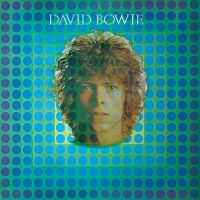 Recorded: 20 June – October 1969
Recorded: 20 June – October 1969
Producers: Tony Visconti, Gus Dudgeon
Engineers: Ken Scott, Malcolm Toft, Barry Sheffield
Released: 14 November 1969
Personnel
- David Bowie: vocals, 12-string acoustic guitar, Stylophone, kalimba, Rosedale electric chord organ
- Mick Wayne, Keith Christmas: guitar
- Mick Ronson: guitar, handclaps
- Tony Visconti, Herbie Flowers, John ‘Honk’ Lodge: bass guitar
- John Cambridge, Terry Cox: drums
- Tim Renwick: electric guitar, flute, recorder
- Rick Wakeman: Mellotron, electric harpsichord
- Benny Marshall and Friends: harmonica
- Marc Bolan, Bob Harris, Sue Harris, Tony Woollcott, Girl: backing vocals
Tracklisting
Contents
- ‘Space Oddity’
- ‘Unwashed And Somewhat Slightly Dazed’
- ‘Don’t Sit Down’
- ‘Letter To Hermione’
- ‘Cygnet Committee’
- ‘Janine’
- ‘An Occasional Dream’
- ‘Wild Eyed Boy From Freecloud’
- ‘God Knows I’m Good’
- ‘Memory Of A Free Festival’
David Bowie’s self-titled second album, often known as Space Oddity, saw him move away from the Anthony Newly-inspired juvenilia of his 1967 debut, into folk rock, progressive rock and acoustic balladry.
In early 1968 Bowie met actress and dancer Hermione Farthingale. They fell in love and moved into a rented room in a Victorian house on Clareville Grove in South Kensington, London. They formed the song-and-mime trio Turquoise with guitarist Tony Hill, which was renamed Feathers after Hill left and was replaced with John ‘Hutch’ Hutchinson.
Bowie and Farthingale separated in early 1969, shortly after the dissolution of Feathers. She had become disenchanted by his lack of fidelity, and wished to resume her own career. Bowie was deeply affected by the end of the relationship, and it fuelled the inspiration for several of the songs on his second long-player, most notably ‘Letter To Hermione’, ‘An Occasional Dream’, and ‘Unwashed And Somewhat Slightly Dazed’.
In April 1969 Bowie and Hutch recorded acoustic demos of ten new songs. They included embryonic versions of five songs that appeared on his second album: ‘Space Oddity’, ‘Janine’, ‘An Occasional Dream’, ‘I’m Not Quite’ (later retitled ‘Letter To Hermione’) and ‘Lover To The Dawn’ (which became ‘Cygnet Committee’).
Also that month, Bowie’s manager Kenneth Pitt convinced Mercury Records’ Simon Hayes to fund and release the album. Hayes suggested that Bowie work with George Martin, only for Pitt to be rebuffed by the Beatles’ producer. He instead invited Tony Visconti, who had worked on some of Bowie’s Deram recordings, to produce the album.
As a novice producer at the time I seem to remember the music more than the technology. I was in the studio more often than in the control room. We used a variety of engineers including the co-owner of Trident Studios, Barry Sheffield, and Malcolm Toft who designed the Trident equipment. I left the sounds to whomever was assigned to us. To me the music was more important. This album will never go down in history for its sonic greatness. I think modern mastering can bring up the low end more, it’s there on tape. We used to mix on gigantic Tannoy speakers at Trident that put out much more bass than anyone had at home. I always felt like too much bass was audible in the control room. I can’t remember dates, those diaries are long gone but I clearly remember the musicians involved, their enthusiasm and smiling faces. I remember David full of excitement and having a strong belief in himself and his genius songs. I shared that with him.
Five Years (1969-1973) book

When I first discovered that John Lodge was one of the bassists, I wasn’t sure if it was John Lodge from The Moody Blues or another bassist with the same name.
Hey! Congratulations for this amazing page, its really great to have every single piece of information of David’s discography in one place.
I really would like to know your opinion about the new Tony Visconti mix in Dolby Atmos immersive sound.
Have you got the opportunity to listen to it?
Thanks in Advance,
Juan,